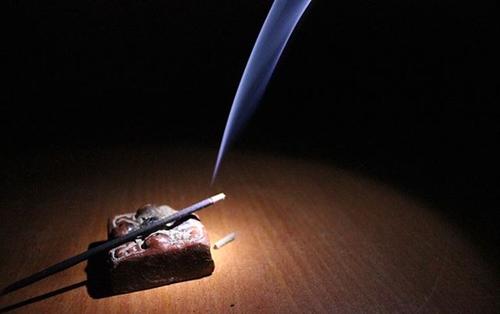What¿s that Waft?
Today, there are thousands of incenses available at a reasonable price. We review here some of the most popular, from amber to ylang-ylang.
No one knows for sure when humans started burning incense. It was probably soon after fire was discovered. It did not take our ancestors long to realise that different types of plants gave different aromas when set on fire, and they soon began throwing specific leaves or twigs on fires with the sole purpose of making their caves smell better.
Fast forward tens of thousands of years, and we come upon Romans, who gave the practice of burning sweet-smelling substances the name it still bears: incense (incendere is Latin for to burn).
Over time, two distinct methods of burning substances to release the aromatic elements developed: direct and indirect. The direct-burning method involves burning a stick (or a cone, or a cylinder) made out of fragrant substances, to which coal or wood powder may be added. When set alight, the stick burns slowly and the ember releases the fragrance.
The indirect-burning method involves heating fragrant substances without setting them alight; instead, they are placed on a hot surface, usually in an incense burner. The direct method is the one we commonly use in our homes; the indirect method is often seen in religious ceremonies.
As to which specific aromatic elements in incense are responsible for giving us olfactory satisfaction, the answer is: practically anything that smells good can be (and at some point probably was) used as incense. Thousands of years ago, the substances that produced the best aroma when burnt were traded as highly desirable commodities. Frankincense from the Arabian Peninsula was for centuries more valuable than gold or silver.
Today, practically every kind of incense is accessible to just about everyone at reasonable prices.
Here are some of the most popular incenses:

Cedar wood: The aroma wafting from a burning cedar incense stick will remind of the natural scent of a cedar forest. Cedar is also used as an insect repellent and is credited with purifying properties.
Cinnamon: The characteristic aroma of cinnamon is for some indelibly linked to pancakes; others find it just as desirable when burnt in the form of incense.
Eucalyptus: Another good insect repellent, eucalyptus incense emits an intense grassy and herbal aroma.
Frankincense: Frankincense is said to promote calm and peace, as well as vitality and a sunny disposition. This incense is often used in religious rituals.
Jasmine: The irresistible fragrance of jasmine is associated with love and beauty.
Lavender: The sweet, strong aroma of lavender is a long-time familiar of linen cupboards for its insect repellent properties.
Lemongrass: The fresh citrus aroma makes lemongrass a popular substance for incense (in addition to its use as food flavouring).
Lotus: The scent of lotus has a rich, intoxicating quality that evokes the warm, misty tropical forests.
Magnolia: This subtle yet distinct sweet fragrance with a hint of lemon exudes freshness.
Myrrh: The earthy, woody, mildly sweet aroma of myrrh is said to be conducive for prayer and meditation. Mixed with frankincense, myrrh is used in the services of many Christian churches: Orthodox, Roman Catholic, Anglican and Episcopal.
Patchouli: This exotic fragrance has a rich, earthy, woody aroma with a fruity note and a hint of musk.
Rose: The sweet floral scent of rose incense will find favour with many.
Rosemary: With its clean, purifying herbal aroma rosemary brings echoes of a Mediterranean garden.
Sandalwood: The scent of this wood has been described as soft, warm, smooth, creamy and milky. It is believed that sandalwood has been in use as incense for at least 4000 years. Sandalwood is also purported to be one of the most calming incenses.
Vanilla: Another of several spices and food flavourings that¿s happy to give off the well-known and well-loved aroma when set alight.
Violet: The sweet, ethereal scent of wild violets will bring refinement to any room. (Note that the popular house plant African violet is not related to this genus; furthermore, since African violet is odourless, it is a mystery where ¿African violet¿ incense gets their aroma from.)
Ylang-ylang: The rich and deep fragrance of ylang-ylang flowers is reminiscent of jasmine.

Besides the role of overcoming bad smells, incense burning has been associated with spiritual upliftment, meditation and even with healing. Different incenses have been said to: calm, soothe, stimulate, invigorate, raise energy, combat depression treat respiratory ailments, help relieve headaches, cure insomnia, relieve high blood pressure¿ Many are also considered to have aphrodisiac qualities.
However, it must be noted that one and same incense can affect different people differently: some will find a particular aroma calming, while to others it will be overpowering and nauseating.
What¿s more, some researchers claim that the miniscule particles of ashes produced when burning incense could be very bad for our lungs. While studies are inconclusive, we all know that anything that burns releases less desirable by-products. Therefore, it is probably a good idea to place incense as far as possible from the sitting area; to ventilate the room often; to avoid burning it around children; and to buy good quality products.
All in all, a great majority of us can certainly enjoy the aromas released by your favourite incense if you do it in moderation and use common sense.